Refine search
No keyword found to refine search
keywords EN
Places
Names
773 documents found
| 1 | 13 |
Documents per page :

The Lompoul desert threatened by mining
Nicolas Réméné / Le Pictorium
LePictorium_0300662.jpg
View of the tents of an ecolodge located in the middle of the dunes in the Lompoul desert in Senegal, December 20, 2018. The Lompoul desert located between Dakar and Saint-Louis about 200km north of the Senegalese capital is an environmental site remarkable which attracts a large number of tourists each year. This natural space, through various tourist activities in particular, therefore plays an important role for employment and the local economy. The Lompoul desert, which is full of minerals, particularly zircon, is today threatened by mining carried out by Grande Côte Opérations (GCO), the Senegalese subsidiary of the French group Eramet. This, which began a few years ago, is already progressing a little more every day, devouring the coastal dune and undermining the entire band of casuarina trees, whose aim is to fight against coastal erosion by fixing the barrier. dune along the seafront.
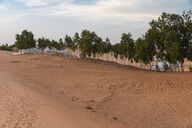
The Lompoul desert threatened by mining
Nicolas Réméné / Le Pictorium
LePictorium_0300663.jpg
View of the tents of an ecolodge located in the middle of the dunes in the Lompoul desert in Senegal, December 20, 2018. The Lompoul desert located between Dakar and Saint-Louis about 200km north of the Senegalese capital is an environmental site remarkable which attracts a large number of tourists each year. This natural space, through various tourist activities in particular, therefore plays an important role for employment and the local economy. The Lompoul desert, which is full of minerals, particularly zircon, is today threatened by mining carried out by Grande Côte Opérations (GCO), the Senegalese subsidiary of the French group Eramet. This, which began a few years ago, is already progressing a little more every day, devouring the coastal dune and undermining the entire band of casuarina trees, whose aim is to fight against coastal erosion by fixing the barrier. dune along the seafront.

The Lompoul desert threatened by mining
Nicolas Réméné / Le Pictorium
LePictorium_0300664.jpg
View of the tents of an ecolodge located in the middle of the dunes in the Lompoul desert in Senegal, December 20, 2018. The Lompoul desert located between Dakar and Saint-Louis about 200km north of the Senegalese capital is an environmental site remarkable which attracts a large number of tourists each year. This natural space, through various tourist activities in particular, therefore plays an important role for employment and the local economy. The Lompoul desert, which is full of minerals, particularly zircon, is today threatened by mining carried out by Grande Côte Opérations (GCO), the Senegalese subsidiary of the French group Eramet. This, which began a few years ago, is already progressing a little more every day, devouring the coastal dune and undermining the entire band of casuarina trees, whose aim is to fight against coastal erosion by fixing the barrier. dune along the seafront.

The Lompoul desert threatened by mining
Nicolas Réméné / Le Pictorium
LePictorium_0300665.jpg
View of the tents of an ecolodge located in the middle of the dunes in the Lompoul desert in Senegal, December 20, 2018. The Lompoul desert located between Dakar and Saint-Louis about 200km north of the Senegalese capital is an environmental site remarkable which attracts a large number of tourists each year. This natural space, through various tourist activities in particular, therefore plays an important role for employment and the local economy. The Lompoul desert, which is full of minerals, particularly zircon, is today threatened by mining carried out by Grande Côte Opérations (GCO), the Senegalese subsidiary of the French group Eramet. This, which began a few years ago, is already progressing a little more every day, devouring the coastal dune and undermining the entire band of casuarina trees, whose aim is to fight against coastal erosion by fixing the barrier. dune along the seafront.

The Lompoul desert threatened by mining
Nicolas Réméné / Le Pictorium
LePictorium_0300666.jpg
View of the tents of an ecolodge located in the middle of the dunes in the Lompoul desert in Senegal, December 20, 2018. The Lompoul desert located between Dakar and Saint-Louis about 200km north of the Senegalese capital is an environmental site remarkable which attracts a large number of tourists each year. This natural space, through various tourist activities in particular, therefore plays an important role for employment and the local economy. The Lompoul desert, which is full of minerals, particularly zircon, is today threatened by mining carried out by Grande Côte Opérations (GCO), the Senegalese subsidiary of the French group Eramet. This, which began a few years ago, is already progressing a little more every day, devouring the coastal dune and undermining the entire band of casuarina trees, whose aim is to fight against coastal erosion by fixing the barrier. dune along the seafront.

The Lompoul desert threatened by mining
Nicolas Réméné / Le Pictorium
LePictorium_0300667.jpg
View of the tents of an ecolodge located in the middle of the dunes in the Lompoul desert in Senegal, December 20, 2018. The Lompoul desert located between Dakar and Saint-Louis about 200km north of the Senegalese capital is an environmental site remarkable which attracts a large number of tourists each year. This natural space, through various tourist activities in particular, therefore plays an important role for employment and the local economy. The Lompoul desert, which is full of minerals, particularly zircon, is today threatened by mining carried out by Grande Côte Opérations (GCO), the Senegalese subsidiary of the French group Eramet. This, which began a few years ago, is already progressing a little more every day, devouring the coastal dune and undermining the entire band of casuarina trees, whose aim is to fight against coastal erosion by fixing the barrier. dune along the seafront.

The Lompoul desert threatened by mining
Nicolas Réméné / Le Pictorium
LePictorium_0300668.jpg
View of the tents of an ecolodge located in the middle of the dunes in the Lompoul desert in Senegal, December 20, 2018. The Lompoul desert located between Dakar and Saint-Louis about 200km north of the Senegalese capital is an environmental site remarkable which attracts a large number of tourists each year. This natural space, through various tourist activities in particular, therefore plays an important role for employment and the local economy. The Lompoul desert, which is full of minerals, particularly zircon, is today threatened by mining carried out by Grande Côte Opérations (GCO), the Senegalese subsidiary of the French group Eramet. This, which began a few years ago, is already progressing a little more every day, devouring the coastal dune and undermining the entire band of casuarina trees, whose aim is to fight against coastal erosion by fixing the barrier. dune along the seafront.
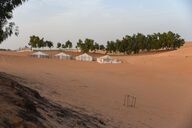
The Lompoul desert threatened by mining
Nicolas Réméné / Le Pictorium
LePictorium_0300669.jpg
View of the tents of an ecolodge located in the middle of the dunes in the Lompoul desert in Senegal, December 20, 2018. The Lompoul desert located between Dakar and Saint-Louis about 200km north of the Senegalese capital is an environmental site remarkable which attracts a large number of tourists each year. This natural space, through various tourist activities in particular, therefore plays an important role for employment and the local economy. The Lompoul desert, which is full of minerals, particularly zircon, is today threatened by mining carried out by Grande Côte Opérations (GCO), the Senegalese subsidiary of the French group Eramet. This, which began a few years ago, is already progressing a little more every day, devouring the coastal dune and undermining the entire band of casuarina trees, whose aim is to fight against coastal erosion by fixing the barrier. dune along the seafront.

The Lompoul desert threatened by mining
Nicolas Réméné / Le Pictorium
LePictorium_0300670.jpg
View of the tents of an ecolodge located in the middle of the dunes in the Lompoul desert in Senegal, December 20, 2018. The Lompoul desert located between Dakar and Saint-Louis about 200km north of the Senegalese capital is an environmental site remarkable which attracts a large number of tourists each year. This natural space, through various tourist activities in particular, therefore plays an important role for employment and the local economy. The Lompoul desert, which is full of minerals, particularly zircon, is today threatened by mining carried out by Grande Côte Opérations (GCO), the Senegalese subsidiary of the French group Eramet. This, which began a few years ago, is already progressing a little more every day, devouring the coastal dune and undermining the entire band of casuarina trees, whose aim is to fight against coastal erosion by fixing the barrier. dune along the seafront.

The Lompoul desert threatened by mining
Nicolas Réméné / Le Pictorium
LePictorium_0300671.jpg
View of the tents of an ecolodge located in the middle of the dunes in the Lompoul desert in Senegal, December 20, 2018. The Lompoul desert located between Dakar and Saint-Louis about 200km north of the Senegalese capital is an environmental site remarkable which attracts a large number of tourists each year. This natural space, through various tourist activities in particular, therefore plays an important role for employment and the local economy. The Lompoul desert, which is full of minerals, particularly zircon, is today threatened by mining carried out by Grande Côte Opérations (GCO), the Senegalese subsidiary of the French group Eramet. This, which began a few years ago, is already progressing a little more every day, devouring the coastal dune and undermining the entire band of casuarina trees, whose aim is to fight against coastal erosion by fixing the barrier. dune along the seafront.

The Lompoul desert threatened by mining
Nicolas Réméné / Le Pictorium
LePictorium_0300672.jpg
View of the tents of an ecolodge located in the middle of the dunes in the Lompoul desert in Senegal, December 20, 2018. The Lompoul desert located between Dakar and Saint-Louis about 200km north of the Senegalese capital is an environmental site remarkable which attracts a large number of tourists each year. This natural space, through various tourist activities in particular, therefore plays an important role for employment and the local economy. The Lompoul desert, which is full of minerals, particularly zircon, is today threatened by mining carried out by Grande Côte Opérations (GCO), the Senegalese subsidiary of the French group Eramet. This, which began a few years ago, is already progressing a little more every day, devouring the coastal dune and undermining the entire band of casuarina trees, whose aim is to fight against coastal erosion by fixing the barrier. dune along the seafront.

The Lompoul desert threatened by mining
Nicolas Réméné / Le Pictorium
LePictorium_0300673.jpg
View of the tents of an ecolodge located in the middle of the dunes in the Lompoul desert in Senegal, December 20, 2018. The Lompoul desert located between Dakar and Saint-Louis about 200km north of the Senegalese capital is an environmental site remarkable which attracts a large number of tourists each year. This natural space, through various tourist activities in particular, therefore plays an important role for employment and the local economy. The Lompoul desert, which is full of minerals, particularly zircon, is today threatened by mining carried out by Grande Côte Opérations (GCO), the Senegalese subsidiary of the French group Eramet. This, which began a few years ago, is already progressing a little more every day, devouring the coastal dune and undermining the entire band of casuarina trees, whose aim is to fight against coastal erosion by fixing the barrier. dune along the seafront.

The Lompoul desert threatened by mining
Nicolas Réméné / Le Pictorium
LePictorium_0300674.jpg
View of the tents of an ecolodge located in the middle of the dunes in the Lompoul desert in Senegal, December 20, 2018. The Lompoul desert located between Dakar and Saint-Louis about 200km north of the Senegalese capital is an environmental site remarkable which attracts a large number of tourists each year. This natural space, through various tourist activities in particular, therefore plays an important role for employment and the local economy. The Lompoul desert, which is full of minerals, particularly zircon, is today threatened by mining carried out by Grande Côte Opérations (GCO), the Senegalese subsidiary of the French group Eramet. This, which began a few years ago, is already progressing a little more every day, devouring the coastal dune and undermining the entire band of casuarina trees, whose aim is to fight against coastal erosion by fixing the barrier. dune along the seafront.

The Lompoul desert threatened by mining
Nicolas Réméné / Le Pictorium
LePictorium_0300675.jpg
View of the tents of an ecolodge located in the middle of the dunes in the Lompoul desert in Senegal, December 20, 2018. The Lompoul desert located between Dakar and Saint-Louis about 200km north of the Senegalese capital is an environmental site remarkable which attracts a large number of tourists each year. This natural space, through various tourist activities in particular, therefore plays an important role for employment and the local economy. The Lompoul desert, which is full of minerals, particularly zircon, is today threatened by mining carried out by Grande Côte Opérations (GCO), the Senegalese subsidiary of the French group Eramet. This, which began a few years ago, is already progressing a little more every day, devouring the coastal dune and undermining the entire band of casuarina trees, whose aim is to fight against coastal erosion by fixing the barrier. dune along the seafront.

The Lompoul desert threatened by mining
Nicolas Réméné / Le Pictorium
LePictorium_0300676.jpg
View of the tents of an ecolodge located in the middle of the dunes in the Lompoul desert in Senegal, December 20, 2018. The Lompoul desert located between Dakar and Saint-Louis about 200km north of the Senegalese capital is an environmental site remarkable which attracts a large number of tourists each year. This natural space, through various tourist activities in particular, therefore plays an important role for employment and the local economy. The Lompoul desert, which is full of minerals, particularly zircon, is today threatened by mining carried out by Grande Côte Opérations (GCO), the Senegalese subsidiary of the French group Eramet. This, which began a few years ago, is already progressing a little more every day, devouring the coastal dune and undermining the entire band of casuarina trees, whose aim is to fight against coastal erosion by fixing the barrier. dune along the seafront.

The Lompoul desert threatened by mining
Nicolas Réméné / Le Pictorium
LePictorium_0300677.jpg
View of the tents of an ecolodge located in the middle of the dunes in the Lompoul desert in Senegal, December 20, 2018. The Lompoul desert located between Dakar and Saint-Louis about 200km north of the Senegalese capital is an environmental site remarkable which attracts a large number of tourists each year. This natural space, through various tourist activities in particular, therefore plays an important role for employment and the local economy. The Lompoul desert, which is full of minerals, particularly zircon, is today threatened by mining carried out by Grande Côte Opérations (GCO), the Senegalese subsidiary of the French group Eramet. This, which began a few years ago, is already progressing a little more every day, devouring the coastal dune and undermining the entire band of casuarina trees, whose aim is to fight against coastal erosion by fixing the barrier. dune along the seafront.

The Lompoul desert threatened by mining
Nicolas Réméné / Le Pictorium
LePictorium_0300678.jpg
View of the tents of an ecolodge located in the middle of the dunes in the Lompoul desert in Senegal, December 20, 2018. The Lompoul desert located between Dakar and Saint-Louis about 200km north of the Senegalese capital is an environmental site remarkable which attracts a large number of tourists each year. This natural space, through various tourist activities in particular, therefore plays an important role for employment and the local economy. The Lompoul desert, which is full of minerals, particularly zircon, is today threatened by mining carried out by Grande Côte Opérations (GCO), the Senegalese subsidiary of the French group Eramet. This, which began a few years ago, is already progressing a little more every day, devouring the coastal dune and undermining the entire band of casuarina trees, whose aim is to fight against coastal erosion by fixing the barrier. dune along the seafront.

The Lompoul desert threatened by mining
Nicolas Réméné / Le Pictorium
LePictorium_0300679.jpg
View of the tents of an ecolodge located in the middle of the dunes in the Lompoul desert in Senegal, December 20, 2018. The Lompoul desert located between Dakar and Saint-Louis about 200km north of the Senegalese capital is an environmental site remarkable which attracts a large number of tourists each year. This natural space, through various tourist activities in particular, therefore plays an important role for employment and the local economy. The Lompoul desert, which is full of minerals, particularly zircon, is today threatened by mining carried out by Grande Côte Opérations (GCO), the Senegalese subsidiary of the French group Eramet. This, which began a few years ago, is already progressing a little more every day, devouring the coastal dune and undermining the entire band of casuarina trees, whose aim is to fight against coastal erosion by fixing the barrier. dune along the seafront.
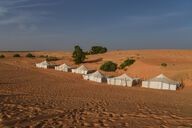
The Lompoul desert threatened by mining
Nicolas Réméné / Le Pictorium
LePictorium_0300680.jpg
View of the tents of an ecolodge located in the middle of the dunes in the Lompoul desert in Senegal, December 20, 2018. The Lompoul desert located between Dakar and Saint-Louis about 200km north of the Senegalese capital is an environmental site remarkable which attracts a large number of tourists each year. This natural space, through various tourist activities in particular, therefore plays an important role for employment and the local economy. The Lompoul desert, which is full of minerals, particularly zircon, is today threatened by mining carried out by Grande Côte Opérations (GCO), the Senegalese subsidiary of the French group Eramet. This, which began a few years ago, is already progressing a little more every day, devouring the coastal dune and undermining the entire band of casuarina trees, whose aim is to fight against coastal erosion by fixing the barrier. dune along the seafront.
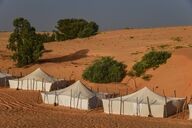
The Lompoul desert threatened by mining
Nicolas Réméné / Le Pictorium
LePictorium_0300681.jpg
View of the tents of an ecolodge located in the middle of the dunes in the Lompoul desert in Senegal, December 20, 2018. The Lompoul desert located between Dakar and Saint-Louis about 200km north of the Senegalese capital is an environmental site remarkable which attracts a large number of tourists each year. This natural space, through various tourist activities in particular, therefore plays an important role for employment and the local economy. The Lompoul desert, which is full of minerals, particularly zircon, is today threatened by mining carried out by Grande Côte Opérations (GCO), the Senegalese subsidiary of the French group Eramet. This, which began a few years ago, is already progressing a little more every day, devouring the coastal dune and undermining the entire band of casuarina trees, whose aim is to fight against coastal erosion by fixing the barrier. dune along the seafront.
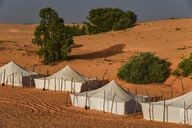
The Lompoul desert threatened by mining
Nicolas Réméné / Le Pictorium
LePictorium_0300682.jpg
View of the tents of an ecolodge located in the middle of the dunes in the Lompoul desert in Senegal, December 20, 2018. The Lompoul desert located between Dakar and Saint-Louis about 200km north of the Senegalese capital is an environmental site remarkable which attracts a large number of tourists each year. This natural space, through various tourist activities in particular, therefore plays an important role for employment and the local economy. The Lompoul desert, which is full of minerals, particularly zircon, is today threatened by mining carried out by Grande Côte Opérations (GCO), the Senegalese subsidiary of the French group Eramet. This, which began a few years ago, is already progressing a little more every day, devouring the coastal dune and undermining the entire band of casuarina trees, whose aim is to fight against coastal erosion by fixing the barrier. dune along the seafront.
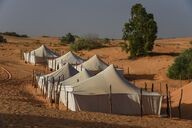
The Lompoul desert threatened by mining
Nicolas Réméné / Le Pictorium
LePictorium_0300683.jpg
View of the tents of an ecolodge located in the middle of the dunes in the Lompoul desert in Senegal, December 20, 2018. The Lompoul desert located between Dakar and Saint-Louis about 200km north of the Senegalese capital is an environmental site remarkable which attracts a large number of tourists each year. This natural space, through various tourist activities in particular, therefore plays an important role for employment and the local economy. The Lompoul desert, which is full of minerals, particularly zircon, is today threatened by mining carried out by Grande Côte Opérations (GCO), the Senegalese subsidiary of the French group Eramet. This, which began a few years ago, is already progressing a little more every day, devouring the coastal dune and undermining the entire band of casuarina trees, whose aim is to fight against coastal erosion by fixing the barrier. dune along the seafront.

The Lompoul desert threatened by mining
Nicolas Réméné / Le Pictorium
LePictorium_0300684.jpg
View of the tents of an ecolodge located in the middle of the dunes in the Lompoul desert in Senegal, December 20, 2018. The Lompoul desert located between Dakar and Saint-Louis about 200km north of the Senegalese capital is an environmental site remarkable which attracts a large number of tourists each year. This natural space, through various tourist activities in particular, therefore plays an important role for employment and the local economy. The Lompoul desert, which is full of minerals, particularly zircon, is today threatened by mining carried out by Grande Côte Opérations (GCO), the Senegalese subsidiary of the French group Eramet. This, which began a few years ago, is already progressing a little more every day, devouring the coastal dune and undermining the entire band of casuarina trees, whose aim is to fight against coastal erosion by fixing the barrier. dune along the seafront.

The Lompoul desert threatened by mining
Nicolas Réméné / Le Pictorium
LePictorium_0300685.jpg
View of the tents of an ecolodge located in the middle of the dunes in the Lompoul desert in Senegal, December 20, 2018. The Lompoul desert located between Dakar and Saint-Louis about 200km north of the Senegalese capital is an environmental site remarkable which attracts a large number of tourists each year. This natural space, through various tourist activities in particular, therefore plays an important role for employment and the local economy. The Lompoul desert, which is full of minerals, particularly zircon, is today threatened by mining carried out by Grande Côte Opérations (GCO), the Senegalese subsidiary of the French group Eramet. This, which began a few years ago, is already progressing a little more every day, devouring the coastal dune and undermining the entire band of casuarina trees, whose aim is to fight against coastal erosion by fixing the barrier. dune along the seafront.

The Lompoul desert threatened by mining
Nicolas Réméné / Le Pictorium
LePictorium_0300686.jpg
A guide with his camels waits for clients at the ecolodge located in the middle of the dunes in the Lompoul desert in Senegal, December 20, 2018. The Lompoul desert located between Dakar and Saint-Louis about 200km north of the Senegalese capital is a remarkable environmental site which attracts a large number of tourists each year. This natural space, through various tourist activities in particular, therefore plays an important role for employment and the local economy. The Lompoul desert, which is full of minerals, particularly zircon, is today threatened by mining carried out by Grande Côte Opérations (GCO), the Senegalese subsidiary of the French group Eramet. This, which began a few years ago, is already progressing a little more every day, devouring the coastal dune and undermining the entire band of casuarina trees, whose aim is to fight against coastal erosion by fixing the barrier. dune along the seafront.

The Lompoul desert threatened by mining
Nicolas Réméné / Le Pictorium
LePictorium_0300687.jpg
A guide with his camels waits for clients at the ecolodge located in the middle of the dunes in the Lompoul desert in Senegal, December 20, 2018. The Lompoul desert located between Dakar and Saint-Louis about 200km north of the Senegalese capital is a remarkable environmental site which attracts a large number of tourists each year. This natural space, through various tourist activities in particular, therefore plays an important role for employment and the local economy. The Lompoul desert, which is full of minerals, particularly zircon, is today threatened by mining carried out by Grande Côte Opérations (GCO), the Senegalese subsidiary of the French group Eramet. This, which began a few years ago, is already progressing a little more every day, devouring the coastal dune and undermining the entire band of casuarina trees, whose aim is to fight against coastal erosion by fixing the barrier. dune along the seafront.

The Lompoul desert threatened by mining
Nicolas Réméné / Le Pictorium
LePictorium_0300688.jpg
Artist Dr. Ziz (Serigne Abdoul Aziz Gueye) drawing in the Lompoul desert in Senegal, December 20, 2018. The Lompoul desert located between Dakar and Saint-Louis about 200km north of the Senegalese capital is a remarkable environmental site that attracts a large number of tourists each year. This natural space, through various tourist activities in particular, therefore plays an important role for employment and the local economy. The Lompoul desert, which is full of minerals, particularly zircon, is today threatened by mining carried out by Grande Côte Opérations (GCO), the Senegalese subsidiary of the French group Eramet. This, which began a few years ago, is already progressing a little more every day, devouring the coastal dune and undermining the entire band of casuarina trees, whose aim is to fight against coastal erosion by fixing the barrier. dune along the seafront.

The Lompoul desert threatened by mining
Nicolas Réméné / Le Pictorium
LePictorium_0300689.jpg
Artist Dr. Ziz (Serigne Abdoul Aziz Gueye) drawing in the Lompoul desert in Senegal, December 20, 2018. The Lompoul desert located between Dakar and Saint-Louis about 200km north of the Senegalese capital is a remarkable environmental site that attracts a large number of tourists each year. This natural space, through various tourist activities in particular, therefore plays an important role for employment and the local economy. The Lompoul desert, which is full of minerals, particularly zircon, is today threatened by mining carried out by Grande Côte Opérations (GCO), the Senegalese subsidiary of the French group Eramet. This, which began a few years ago, is already progressing a little more every day, devouring the coastal dune and undermining the entire band of casuarina trees, whose aim is to fight against coastal erosion by fixing the barrier. dune along the seafront.

The Lompoul desert threatened by mining
Nicolas Réméné / Le Pictorium
LePictorium_0300690.jpg
Artist Dr. Ziz (Serigne Abdoul Aziz Gueye) drawing in the Lompoul desert in Senegal, December 20, 2018. The Lompoul desert located between Dakar and Saint-Louis about 200km north of the Senegalese capital is a remarkable environmental site that attracts a large number of tourists each year. This natural space, through various tourist activities in particular, therefore plays an important role for employment and the local economy. The Lompoul desert, which is full of minerals, particularly zircon, is today threatened by mining carried out by Grande Côte Opérations (GCO), the Senegalese subsidiary of the French group Eramet. This, which began a few years ago, is already progressing a little more every day, devouring the coastal dune and undermining the entire band of casuarina trees, whose aim is to fight against coastal erosion by fixing the barrier. dune along the seafront.

Exile in the land of human rights
Michael Bunel / Le Pictorium
LePictorium_0286272.jpg
Migrants join the shantytown before the arrival of the forces of order for the evacuation of the millenaire camp. This is the 35th dismantling in Paris in the last 3 years. The people are to be taken to accommodation centers while their administrative situations are studied. May 30, 2018. Paris. France.
In October 2015, the municipality presented eighteen commitments in a document entitled "Mobilizing the Paris community to welcome refugees". The document opens with this sentence: "Paris, like other refugee cities, will rise to the challenge of welcoming the many migrants currently arriving in Europe." One year on, and with the city of Paris already struggling to fulfill its commitment, the dismantling of the Calais Jungle in October 2016 has led to some refugees retreating to the capital. Camps then sprang up, notably in north-east Paris on the banks of the Canal Saint Martin, then at Porte de la Chapelle and Porte d'Aubervilliers. The dismantling of these camps has continued apace. Since June 2015, 300 evacuations and "shelters" of refugees have taken place in Paris and its inner suburbs. These settlements, followed by their evacuation, give the image of an identical repetition of a catastrophic situation of precariousness and a lack of public action. Invisibilized since the last dismantling operations, the exile populations find themselves rejected on the outskirts of the capital. Only a few associations still manage to maintain contact by seeking out the living quarters of those left behind.
In October 2015, the municipality presented eighteen commitments in a document entitled "Mobilizing the Paris community to welcome refugees". The document opens with this sentence: "Paris, like other refugee cities, will rise to the challenge of welcoming the many migrants currently arriving in Europe." One year on, and with the city of Paris already struggling to fulfill its commitment, the dismantling of the Calais Jungle in October 2016 has led to some refugees retreating to the capital. Camps then sprang up, notably in north-east Paris on the banks of the Canal Saint Martin, then at Porte de la Chapelle and Porte d'Aubervilliers. The dismantling of these camps has continued apace. Since June 2015, 300 evacuations and "shelters" of refugees have taken place in Paris and its inner suburbs. These settlements, followed by their evacuation, give the image of an identical repetition of a catastrophic situation of precariousness and a lack of public action. Invisibilized since the last dismantling operations, the exile populations find themselves rejected on the outskirts of the capital. Only a few associations still manage to maintain contact by seeking out the living quarters of those left behind.

Exile in the land of human rights
Michael Bunel / Le Pictorium
LePictorium_0286273.jpg
View of one of the shantytown's banks, still lit up before daybreak and the start of the dismantling of the "millenaire" camp. This is the 35th dismantling in Paris in the last 3 years. People are to be taken to accommodation centers while their administrative situations are reviewed. May 30, 2018. Paris. France.
In October 2015, the municipality presented eighteen commitments in a document entitled "Mobilizing the Paris community to welcome refugees". The document opens with this sentence: "Paris, like other refugee cities, will rise to the challenge of welcoming the many migrants currently arriving in Europe." One year on, and with the city of Paris already struggling to fulfill its commitment, the dismantling of the Calais Jungle in October 2016 has led to some refugees retreating to the capital. Camps then sprang up, notably in north-east Paris on the banks of the Canal Saint Martin, then at Porte de la Chapelle and Porte d'Aubervilliers. The dismantling of these camps has continued apace. Since June 2015, 300 evacuations and "shelters" of refugees have taken place in Paris and its inner suburbs. These settlements, followed by their evacuation, give the image of an identical repetition of a catastrophic situation of precariousness and a lack of public action. Invisibilized since the last dismantling operations, the exile populations find themselves rejected on the outskirts of the capital. Only a few associations still manage to maintain contact by seeking out the living quarters of those left behind.
In October 2015, the municipality presented eighteen commitments in a document entitled "Mobilizing the Paris community to welcome refugees". The document opens with this sentence: "Paris, like other refugee cities, will rise to the challenge of welcoming the many migrants currently arriving in Europe." One year on, and with the city of Paris already struggling to fulfill its commitment, the dismantling of the Calais Jungle in October 2016 has led to some refugees retreating to the capital. Camps then sprang up, notably in north-east Paris on the banks of the Canal Saint Martin, then at Porte de la Chapelle and Porte d'Aubervilliers. The dismantling of these camps has continued apace. Since June 2015, 300 evacuations and "shelters" of refugees have taken place in Paris and its inner suburbs. These settlements, followed by their evacuation, give the image of an identical repetition of a catastrophic situation of precariousness and a lack of public action. Invisibilized since the last dismantling operations, the exile populations find themselves rejected on the outskirts of the capital. Only a few associations still manage to maintain contact by seeking out the living quarters of those left behind.
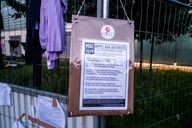
Exile in the land of human rights
Michael Bunel / Le Pictorium
LePictorium_0286274.jpg
Dismantling of the -millenaire- camp. This is the 35th dismantling in Paris in the last 3 years. People are to be taken to accommodation centers while their administrative situations are studied. May 30, 2018. Paris. France.
In October 2015, the municipality presented eighteen commitments in a document entitled "Mobilizing the Paris community to welcome refugees". The document opens with this sentence: "Paris, like other refugee cities, will rise to the challenge of welcoming the many migrants currently arriving in Europe." One year on, and with the city of Paris already struggling to fulfill its commitment, the dismantling of the Calais Jungle in October 2016 has led to some refugees retreating to the capital. Camps then sprang up, notably in north-east Paris on the banks of the Canal Saint Martin, then at Porte de la Chapelle and Porte d'Aubervilliers. The dismantling of these camps has continued apace. Since June 2015, 300 evacuations and "shelters" of refugees have taken place in Paris and its inner suburbs. These settlements, followed by their evacuation, give the image of an identical repetition of a catastrophic situation of precariousness and a lack of public action. Invisibilized since the last dismantling operations, the exile populations find themselves rejected on the outskirts of the capital. Only a few associations still manage to maintain contact by seeking out the living quarters of those left behind.
In October 2015, the municipality presented eighteen commitments in a document entitled "Mobilizing the Paris community to welcome refugees". The document opens with this sentence: "Paris, like other refugee cities, will rise to the challenge of welcoming the many migrants currently arriving in Europe." One year on, and with the city of Paris already struggling to fulfill its commitment, the dismantling of the Calais Jungle in October 2016 has led to some refugees retreating to the capital. Camps then sprang up, notably in north-east Paris on the banks of the Canal Saint Martin, then at Porte de la Chapelle and Porte d'Aubervilliers. The dismantling of these camps has continued apace. Since June 2015, 300 evacuations and "shelters" of refugees have taken place in Paris and its inner suburbs. These settlements, followed by their evacuation, give the image of an identical repetition of a catastrophic situation of precariousness and a lack of public action. Invisibilized since the last dismantling operations, the exile populations find themselves rejected on the outskirts of the capital. Only a few associations still manage to maintain contact by seeking out the living quarters of those left behind.

Exile in the land of human rights
Michael Bunel / Le Pictorium
LePictorium_0286275.jpg
A Sudanese refugee watches migrants leaving on the other platform. He's holding a garbage can bag containing his tent. Dismantling of the -millenaire- camp. This is the 35th dismantling in Paris in the last 3 years. The people are to be taken to accommodation centers while their administrative situation is examined.
In October 2015, the municipality presented eighteen commitments in a document entitled "Mobilizing the Paris community to welcome refugees". The document opens with this sentence: "Paris, like other refugee cities, will rise to the challenge of welcoming the many migrants currently arriving in Europe." One year on, and with the city of Paris already struggling to fulfill its commitment, the dismantling of the Calais Jungle in October 2016 has led to some refugees retreating to the capital. Camps then sprang up, notably in north-east Paris on the banks of the Canal Saint Martin, then at Porte de la Chapelle and Porte d'Aubervilliers. The dismantling of these camps has continued apace. Since June 2015, 300 evacuations and "shelters" of refugees have taken place in Paris and its inner suburbs. These settlements, followed by their evacuation, give the image of an identical repetition of a catastrophic situation of precariousness and a lack of public action. Invisibilized since the last dismantling operations, the exile populations find themselves rejected on the outskirts of the capital. Only a few associations still manage to maintain contact by seeking out the living quarters of those left behind.
In October 2015, the municipality presented eighteen commitments in a document entitled "Mobilizing the Paris community to welcome refugees". The document opens with this sentence: "Paris, like other refugee cities, will rise to the challenge of welcoming the many migrants currently arriving in Europe." One year on, and with the city of Paris already struggling to fulfill its commitment, the dismantling of the Calais Jungle in October 2016 has led to some refugees retreating to the capital. Camps then sprang up, notably in north-east Paris on the banks of the Canal Saint Martin, then at Porte de la Chapelle and Porte d'Aubervilliers. The dismantling of these camps has continued apace. Since June 2015, 300 evacuations and "shelters" of refugees have taken place in Paris and its inner suburbs. These settlements, followed by their evacuation, give the image of an identical repetition of a catastrophic situation of precariousness and a lack of public action. Invisibilized since the last dismantling operations, the exile populations find themselves rejected on the outskirts of the capital. Only a few associations still manage to maintain contact by seeking out the living quarters of those left behind.

Exile in the land of human rights
Michael Bunel / Le Pictorium
LePictorium_0286277.jpg
The migrants, channeled by the forces of law and order, join the buses in groups of ten during the dismantling of the -millenaire- camp. This is the 35th dismantling in Paris in the last 3 years. The people are to be taken to accommodation centers while their administrative situations are reviewed. May 30, 2018. Paris. France.
In October 2015, the municipality presented eighteen commitments in a document entitled "Mobilizing the Paris community to welcome refugees". The document opens with this sentence: "Paris, like other refugee cities, will rise to the challenge of welcoming the many migrants currently arriving in Europe." One year on, and with the city of Paris already struggling to fulfill its commitment, the dismantling of the Calais Jungle in October 2016 has led to some refugees retreating to the capital. Camps then sprang up, notably in north-east Paris on the banks of the Canal Saint Martin, then at Porte de la Chapelle and Porte d'Aubervilliers. The dismantling of these camps has continued apace. Since June 2015, 300 evacuations and "shelters" of refugees have taken place in Paris and its inner suburbs. These settlements, followed by their evacuation, give the image of an identical repetition of a catastrophic situation of precariousness and a lack of public action. Invisibilized since the last dismantling operations, the exile populations find themselves rejected on the outskirts of the capital. Only a few associations still manage to maintain contact by seeking out the living quarters of those left behind.
In October 2015, the municipality presented eighteen commitments in a document entitled "Mobilizing the Paris community to welcome refugees". The document opens with this sentence: "Paris, like other refugee cities, will rise to the challenge of welcoming the many migrants currently arriving in Europe." One year on, and with the city of Paris already struggling to fulfill its commitment, the dismantling of the Calais Jungle in October 2016 has led to some refugees retreating to the capital. Camps then sprang up, notably in north-east Paris on the banks of the Canal Saint Martin, then at Porte de la Chapelle and Porte d'Aubervilliers. The dismantling of these camps has continued apace. Since June 2015, 300 evacuations and "shelters" of refugees have taken place in Paris and its inner suburbs. These settlements, followed by their evacuation, give the image of an identical repetition of a catastrophic situation of precariousness and a lack of public action. Invisibilized since the last dismantling operations, the exile populations find themselves rejected on the outskirts of the capital. Only a few associations still manage to maintain contact by seeking out the living quarters of those left behind.

Exile in the land of human rights
Michael Bunel / Le Pictorium
LePictorium_0286278.jpg
Migrants and refugees board buses during the dismantling of the Millenaire camp. This is the 35th dismantling in Paris in the last 3 years. The people are to be taken to accommodation centers while their administrative situations are studied. May 30, 2018. Paris. France.
In October 2015, the municipality presented eighteen commitments in a document entitled "Mobilizing the Paris community to welcome refugees". The document opens with this sentence: "Paris, like other refugee cities, will rise to the challenge of welcoming the many migrants currently arriving in Europe." One year on, and with the city of Paris already struggling to fulfill its commitment, the dismantling of the Calais Jungle in October 2016 has led to some refugees retreating to the capital. Camps then sprang up, notably in north-east Paris on the banks of the Canal Saint Martin, then at Porte de la Chapelle and Porte d'Aubervilliers. The dismantling of these camps has continued apace. Since June 2015, 300 evacuations and "shelters" of refugees have taken place in Paris and its inner suburbs. These settlements, followed by their evacuation, give the image of an identical repetition of a catastrophic situation of precariousness and a lack of public action. Invisibilized since the last dismantling operations, the exile populations find themselves rejected on the outskirts of the capital. Only a few associations still manage to maintain contact by seeking out the living quarters of those left behind.
In October 2015, the municipality presented eighteen commitments in a document entitled "Mobilizing the Paris community to welcome refugees". The document opens with this sentence: "Paris, like other refugee cities, will rise to the challenge of welcoming the many migrants currently arriving in Europe." One year on, and with the city of Paris already struggling to fulfill its commitment, the dismantling of the Calais Jungle in October 2016 has led to some refugees retreating to the capital. Camps then sprang up, notably in north-east Paris on the banks of the Canal Saint Martin, then at Porte de la Chapelle and Porte d'Aubervilliers. The dismantling of these camps has continued apace. Since June 2015, 300 evacuations and "shelters" of refugees have taken place in Paris and its inner suburbs. These settlements, followed by their evacuation, give the image of an identical repetition of a catastrophic situation of precariousness and a lack of public action. Invisibilized since the last dismantling operations, the exile populations find themselves rejected on the outskirts of the capital. Only a few associations still manage to maintain contact by seeking out the living quarters of those left behind.
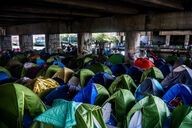
Exile in the land of human rights
Michael Bunel / Le Pictorium
LePictorium_0286279.jpg
Dismantling of the -millenaire- camp. This is the 35th dismantling in Paris in the last 3 years. People are to be taken to accommodation centers while their administrative situations are studied. May 30, 2018. Paris. France.
In October 2015, the municipality presented eighteen commitments in a document entitled "Mobilizing the Paris community to welcome refugees". The document opens with this sentence: "Paris, like other refugee cities, will rise to the challenge of welcoming the many migrants currently arriving in Europe." One year on, and with the city of Paris already struggling to fulfill its commitment, the dismantling of the Calais Jungle in October 2016 has led to some refugees retreating to the capital. Camps then sprang up, notably in north-east Paris on the banks of the Canal Saint Martin, then at Porte de la Chapelle and Porte d'Aubervilliers. The dismantling of these camps has continued apace. Since June 2015, 300 evacuations and "shelters" of refugees have taken place in Paris and its inner suburbs. These settlements, followed by their evacuation, give the image of an identical repetition of a catastrophic situation of precariousness and a lack of public action. Invisibilized since the last dismantling operations, the exile populations find themselves rejected on the outskirts of the capital. Only a few associations still manage to maintain contact by seeking out the living quarters of those left behind.
In October 2015, the municipality presented eighteen commitments in a document entitled "Mobilizing the Paris community to welcome refugees". The document opens with this sentence: "Paris, like other refugee cities, will rise to the challenge of welcoming the many migrants currently arriving in Europe." One year on, and with the city of Paris already struggling to fulfill its commitment, the dismantling of the Calais Jungle in October 2016 has led to some refugees retreating to the capital. Camps then sprang up, notably in north-east Paris on the banks of the Canal Saint Martin, then at Porte de la Chapelle and Porte d'Aubervilliers. The dismantling of these camps has continued apace. Since June 2015, 300 evacuations and "shelters" of refugees have taken place in Paris and its inner suburbs. These settlements, followed by their evacuation, give the image of an identical repetition of a catastrophic situation of precariousness and a lack of public action. Invisibilized since the last dismantling operations, the exile populations find themselves rejected on the outskirts of the capital. Only a few associations still manage to maintain contact by seeking out the living quarters of those left behind.

Exile in the land of human rights
Michael Bunel / Le Pictorium
LePictorium_0286280.jpg
A man emerges from his tent as clean-up crews empty the camp. The police are supposed to make sure that the tents are empty before the clean-up crews intervene. This is the 35th dismantling in Paris in the last 3 years. May 30, 2018. France.
In October 2015, the municipality presented eighteen commitments in a document entitled "Mobilizing the Paris community to welcome refugees". The document opens with this sentence: "Paris, like other refugee cities, will rise to the challenge of welcoming the many migrants currently arriving in Europe." One year on, and with the city of Paris already struggling to fulfill its commitment, the dismantling of the Calais Jungle in October 2016 has led to some refugees retreating to the capital. Camps then sprang up, notably in north-east Paris on the banks of the Canal Saint Martin, then at Porte de la Chapelle and Porte d'Aubervilliers. The dismantling of these camps has continued apace. Since June 2015, 300 evacuations and "shelters" of refugees have taken place in Paris and its inner suburbs. These settlements, followed by their evacuation, give the image of an identical repetition of a catastrophic situation of precariousness and a lack of public action. Invisibilized since the last dismantling operations, the exile populations find themselves rejected on the outskirts of the capital. Only a few associations still manage to maintain contact by seeking out the living quarters of those left behind.
In October 2015, the municipality presented eighteen commitments in a document entitled "Mobilizing the Paris community to welcome refugees". The document opens with this sentence: "Paris, like other refugee cities, will rise to the challenge of welcoming the many migrants currently arriving in Europe." One year on, and with the city of Paris already struggling to fulfill its commitment, the dismantling of the Calais Jungle in October 2016 has led to some refugees retreating to the capital. Camps then sprang up, notably in north-east Paris on the banks of the Canal Saint Martin, then at Porte de la Chapelle and Porte d'Aubervilliers. The dismantling of these camps has continued apace. Since June 2015, 300 evacuations and "shelters" of refugees have taken place in Paris and its inner suburbs. These settlements, followed by their evacuation, give the image of an identical repetition of a catastrophic situation of precariousness and a lack of public action. Invisibilized since the last dismantling operations, the exile populations find themselves rejected on the outskirts of the capital. Only a few associations still manage to maintain contact by seeking out the living quarters of those left behind.

Exile in the land of human rights
Michael Bunel / Le Pictorium
LePictorium_0286281.jpg
Shelter operation after the evacuation of the -millenaire- camp. Migrants and refugees are housed in a gymnasium where they are registered for administrative clarification. Cots have been set up. May 30, 2018. Paris. France.
In October 2015, the municipality presented eighteen commitments in a document entitled "Mobilizing the Paris community to welcome refugees". The document opens with this sentence: "Paris, like other refugee cities, will rise to the challenge of welcoming the many migrants currently arriving in Europe." One year on, and with the city of Paris already struggling to fulfill its commitment, the dismantling of the Calais Jungle in October 2016 has led to some refugees retreating to the capital. Camps then sprang up, notably in north-east Paris on the banks of the Canal Saint Martin, then at Porte de la Chapelle and Porte d'Aubervilliers. The dismantling of these camps has continued apace. Since June 2015, 300 evacuations and "shelters" of refugees have taken place in Paris and its inner suburbs. These settlements, followed by their evacuation, give the image of an identical repetition of a catastrophic situation of precariousness and a lack of public action. Invisibilized since the last dismantling operations, the exile populations find themselves rejected on the outskirts of the capital. Only a few associations still manage to maintain contact by seeking out the living quarters of those left behind.
In October 2015, the municipality presented eighteen commitments in a document entitled "Mobilizing the Paris community to welcome refugees". The document opens with this sentence: "Paris, like other refugee cities, will rise to the challenge of welcoming the many migrants currently arriving in Europe." One year on, and with the city of Paris already struggling to fulfill its commitment, the dismantling of the Calais Jungle in October 2016 has led to some refugees retreating to the capital. Camps then sprang up, notably in north-east Paris on the banks of the Canal Saint Martin, then at Porte de la Chapelle and Porte d'Aubervilliers. The dismantling of these camps has continued apace. Since June 2015, 300 evacuations and "shelters" of refugees have taken place in Paris and its inner suburbs. These settlements, followed by their evacuation, give the image of an identical repetition of a catastrophic situation of precariousness and a lack of public action. Invisibilized since the last dismantling operations, the exile populations find themselves rejected on the outskirts of the capital. Only a few associations still manage to maintain contact by seeking out the living quarters of those left behind.
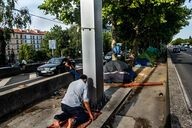
Exile in the land of human rights
Michael Bunel / Le Pictorium
LePictorium_0286291.jpg
An Afghan refugee prays on one of the dividing strips of the northern Paris ring road. July 2019. Paris, France.
In October 2015, the municipality presented eighteen commitments in a document entitled "Mobilizing the Paris community to welcome refugees". The document opens with this sentence: "Paris, like other refugee cities, will rise to the challenge of welcoming the many migrants currently arriving in Europe." One year on, and with the city of Paris already struggling to fulfill its commitment, the dismantling of the Calais Jungle in October 2016 has led to some refugees retreating to the capital. Camps then sprang up, notably in north-east Paris on the banks of the Canal Saint Martin, then at Porte de la Chapelle and Porte d'Aubervilliers. The dismantling of these camps has continued apace. Since June 2015, 300 evacuations and "shelters" of refugees have taken place in Paris and its inner suburbs. These settlements, followed by their evacuation, give the image of an identical repetition of a catastrophic situation of precariousness and a lack of public action. Invisibilized since the last dismantling operations, the exile populations find themselves rejected on the outskirts of the capital. Only a few associations still manage to maintain contact by seeking out the living quarters of those left behind.
In October 2015, the municipality presented eighteen commitments in a document entitled "Mobilizing the Paris community to welcome refugees". The document opens with this sentence: "Paris, like other refugee cities, will rise to the challenge of welcoming the many migrants currently arriving in Europe." One year on, and with the city of Paris already struggling to fulfill its commitment, the dismantling of the Calais Jungle in October 2016 has led to some refugees retreating to the capital. Camps then sprang up, notably in north-east Paris on the banks of the Canal Saint Martin, then at Porte de la Chapelle and Porte d'Aubervilliers. The dismantling of these camps has continued apace. Since June 2015, 300 evacuations and "shelters" of refugees have taken place in Paris and its inner suburbs. These settlements, followed by their evacuation, give the image of an identical repetition of a catastrophic situation of precariousness and a lack of public action. Invisibilized since the last dismantling operations, the exile populations find themselves rejected on the outskirts of the capital. Only a few associations still manage to maintain contact by seeking out the living quarters of those left behind.

Exile in the land of human rights
Michael Bunel / Le Pictorium
LePictorium_0286292.jpg
A rare moment of relaxation. Afghans and Pakistanis get together to play cricket. A few days later, a vigil prevents the refugees from entering the stadium. They'll have to make do with the Parc de la Vilette. July 2019. Paris, France.
In October 2015, the municipality presented eighteen commitments in a document entitled "Mobilizing the Paris community to welcome refugees". The document opens with this sentence: "Paris, like other refugee cities, will rise to the challenge of welcoming the many migrants currently arriving in Europe." One year on, and with the city of Paris already struggling to fulfill its commitment, the dismantling of the Calais Jungle in October 2016 has led to some refugees retreating to the capital. Camps then sprang up, notably in north-east Paris on the banks of the Canal Saint Martin, then at Porte de la Chapelle and Porte d'Aubervilliers. The dismantling of these camps has continued apace. Since June 2015, 300 evacuations and "shelters" of refugees have taken place in Paris and its inner suburbs. These settlements, followed by their evacuation, give the image of an identical repetition of a catastrophic situation of precariousness and a lack of public action. Invisibilized since the last dismantling operations, the exile populations find themselves rejected on the outskirts of the capital. Only a few associations still manage to maintain contact by seeking out the living quarters of those left behind.
In October 2015, the municipality presented eighteen commitments in a document entitled "Mobilizing the Paris community to welcome refugees". The document opens with this sentence: "Paris, like other refugee cities, will rise to the challenge of welcoming the many migrants currently arriving in Europe." One year on, and with the city of Paris already struggling to fulfill its commitment, the dismantling of the Calais Jungle in October 2016 has led to some refugees retreating to the capital. Camps then sprang up, notably in north-east Paris on the banks of the Canal Saint Martin, then at Porte de la Chapelle and Porte d'Aubervilliers. The dismantling of these camps has continued apace. Since June 2015, 300 evacuations and "shelters" of refugees have taken place in Paris and its inner suburbs. These settlements, followed by their evacuation, give the image of an identical repetition of a catastrophic situation of precariousness and a lack of public action. Invisibilized since the last dismantling operations, the exile populations find themselves rejected on the outskirts of the capital. Only a few associations still manage to maintain contact by seeking out the living quarters of those left behind.

Exile in the land of human rights
Michael Bunel / Le Pictorium
LePictorium_0286307.jpg
In recent weeks, a new refugee camp has been set up near the Stade de France, in the commune of Saint Denis (93). Between 600 and 800 people have set up camp in tents under the A1 freeway bridge. September 19, 2020. Paris, France.
In October 2015, the municipality presented eighteen commitments in a document entitled "Mobilizing the Paris community to welcome refugees". The document opens with this sentence: "Paris, like other refugee cities, will rise to the challenge of welcoming the many migrants currently arriving in Europe." One year on, and with the city of Paris already struggling to fulfill its commitment, the dismantling of the Calais Jungle in October 2016 has led to some refugees retreating to the capital. Camps then sprang up, notably in north-east Paris on the banks of the Canal Saint Martin, then at Porte de la Chapelle and Porte d'Aubervilliers. The dismantling of these camps has continued apace. Since June 2015, 300 evacuations and "shelters" of refugees have taken place in Paris and its inner suburbs. These settlements, followed by their evacuation, give the image of an identical repetition of a catastrophic situation of precariousness and a lack of public action. Invisibilized since the last dismantling operations, the exile populations find themselves rejected on the outskirts of the capital. Only a few associations still manage to maintain contact by seeking out the living quarters of those left behind.
In October 2015, the municipality presented eighteen commitments in a document entitled "Mobilizing the Paris community to welcome refugees". The document opens with this sentence: "Paris, like other refugee cities, will rise to the challenge of welcoming the many migrants currently arriving in Europe." One year on, and with the city of Paris already struggling to fulfill its commitment, the dismantling of the Calais Jungle in October 2016 has led to some refugees retreating to the capital. Camps then sprang up, notably in north-east Paris on the banks of the Canal Saint Martin, then at Porte de la Chapelle and Porte d'Aubervilliers. The dismantling of these camps has continued apace. Since June 2015, 300 evacuations and "shelters" of refugees have taken place in Paris and its inner suburbs. These settlements, followed by their evacuation, give the image of an identical repetition of a catastrophic situation of precariousness and a lack of public action. Invisibilized since the last dismantling operations, the exile populations find themselves rejected on the outskirts of the capital. Only a few associations still manage to maintain contact by seeking out the living quarters of those left behind.

Exile in the land of human rights
Michael Bunel / Le Pictorium
LePictorium_0286308.jpg
Saint DenIs, November 17, 2020. Evacuation of the Saint Denis refugee camp. Between 1,500 and 2,000 people have been living in an unsanitary camp for several months. The people are waiting for the evacuation to begin. November 17, 2020. Saint Denis, France.
In October 2015, the municipality presented eighteen commitments in a document entitled "Mobilizing the Paris community to welcome refugees". The document opens with this sentence: "Paris, like other refugee cities, will rise to the challenge of welcoming the many migrants currently arriving in Europe." One year on, and with the city of Paris already struggling to fulfill its commitment, the dismantling of the Calais Jungle in October 2016 has led to some refugees retreating to the capital. Camps then sprang up, notably in north-east Paris on the banks of the Canal Saint Martin, then at Porte de la Chapelle and Porte d'Aubervilliers. The dismantling of these camps has continued apace. Since June 2015, 300 evacuations and "shelters" of refugees have taken place in Paris and its inner suburbs. These settlements, followed by their evacuation, give the image of an identical repetition of a catastrophic situation of precariousness and a lack of public action. Invisibilized since the last dismantling operations, the exile populations find themselves rejected on the outskirts of the capital. Only a few associations still manage to maintain contact by seeking out the living quarters of those left behind.
In October 2015, the municipality presented eighteen commitments in a document entitled "Mobilizing the Paris community to welcome refugees". The document opens with this sentence: "Paris, like other refugee cities, will rise to the challenge of welcoming the many migrants currently arriving in Europe." One year on, and with the city of Paris already struggling to fulfill its commitment, the dismantling of the Calais Jungle in October 2016 has led to some refugees retreating to the capital. Camps then sprang up, notably in north-east Paris on the banks of the Canal Saint Martin, then at Porte de la Chapelle and Porte d'Aubervilliers. The dismantling of these camps has continued apace. Since June 2015, 300 evacuations and "shelters" of refugees have taken place in Paris and its inner suburbs. These settlements, followed by their evacuation, give the image of an identical repetition of a catastrophic situation of precariousness and a lack of public action. Invisibilized since the last dismantling operations, the exile populations find themselves rejected on the outskirts of the capital. Only a few associations still manage to maintain contact by seeking out the living quarters of those left behind.

Exile in the land of human rights
Michael Bunel / Le Pictorium
LePictorium_0286309.jpg
Saint DenIs, November 17, 2020. Evacuation of the Saint Denis refugee camp. Between 1,500 and 2,000 people have been living in an unsanitary camp for several months. The people are waiting for the evacuation to begin. November 17, 2020. Saint Denis, France.
In October 2015, the municipality presented eighteen commitments in a document entitled "Mobilizing the Paris community to welcome refugees". The document opens with this sentence: "Paris, like other refugee cities, will rise to the challenge of welcoming the many migrants currently arriving in Europe." One year on, and with the city of Paris already struggling to fulfill its commitment, the dismantling of the Calais Jungle in October 2016 has led to some refugees retreating to the capital. Camps then sprang up, notably in north-east Paris on the banks of the Canal Saint Martin, then at Porte de la Chapelle and Porte d'Aubervilliers. The dismantling of these camps has continued apace. Since June 2015, 300 evacuations and "shelters" of refugees have taken place in Paris and its inner suburbs. These settlements, followed by their evacuation, give the image of an identical repetition of a catastrophic situation of precariousness and a lack of public action. Invisibilized since the last dismantling operations, the exile populations find themselves rejected on the outskirts of the capital. Only a few associations still manage to maintain contact by seeking out the living quarters of those left behind.
In October 2015, the municipality presented eighteen commitments in a document entitled "Mobilizing the Paris community to welcome refugees". The document opens with this sentence: "Paris, like other refugee cities, will rise to the challenge of welcoming the many migrants currently arriving in Europe." One year on, and with the city of Paris already struggling to fulfill its commitment, the dismantling of the Calais Jungle in October 2016 has led to some refugees retreating to the capital. Camps then sprang up, notably in north-east Paris on the banks of the Canal Saint Martin, then at Porte de la Chapelle and Porte d'Aubervilliers. The dismantling of these camps has continued apace. Since June 2015, 300 evacuations and "shelters" of refugees have taken place in Paris and its inner suburbs. These settlements, followed by their evacuation, give the image of an identical repetition of a catastrophic situation of precariousness and a lack of public action. Invisibilized since the last dismantling operations, the exile populations find themselves rejected on the outskirts of the capital. Only a few associations still manage to maintain contact by seeking out the living quarters of those left behind.

Exile in the land of human rights
Michael Bunel / Le Pictorium
LePictorium_0286310.jpg
Saint DenIs, November 17, 2020. Evacuation of the Saint Denis refugee camp. Between 1,500 and 2,000 people have been living in an unsanitary camp for several months. The people are waiting for the evacuation to begin. November 17, 2020. Saint Denis, France.
In October 2015, the municipality presented eighteen commitments in a document entitled "Mobilizing the Paris community to welcome refugees". The document opens with this sentence: "Paris, like other refugee cities, will rise to the challenge of welcoming the many migrants currently arriving in Europe." One year on, and with the city of Paris already struggling to fulfill its commitment, the dismantling of the Calais Jungle in October 2016 has led to some refugees retreating to the capital. Camps then sprang up, notably in north-east Paris on the banks of the Canal Saint Martin, then at Porte de la Chapelle and Porte d'Aubervilliers. The dismantling of these camps has continued apace. Since June 2015, 300 evacuations and "shelters" of refugees have taken place in Paris and its inner suburbs. These settlements, followed by their evacuation, give the image of an identical repetition of a catastrophic situation of precariousness and a lack of public action. Invisibilized since the last dismantling operations, the exile populations find themselves rejected on the outskirts of the capital. Only a few associations still manage to maintain contact by seeking out the living quarters of those left behind.
In October 2015, the municipality presented eighteen commitments in a document entitled "Mobilizing the Paris community to welcome refugees". The document opens with this sentence: "Paris, like other refugee cities, will rise to the challenge of welcoming the many migrants currently arriving in Europe." One year on, and with the city of Paris already struggling to fulfill its commitment, the dismantling of the Calais Jungle in October 2016 has led to some refugees retreating to the capital. Camps then sprang up, notably in north-east Paris on the banks of the Canal Saint Martin, then at Porte de la Chapelle and Porte d'Aubervilliers. The dismantling of these camps has continued apace. Since June 2015, 300 evacuations and "shelters" of refugees have taken place in Paris and its inner suburbs. These settlements, followed by their evacuation, give the image of an identical repetition of a catastrophic situation of precariousness and a lack of public action. Invisibilized since the last dismantling operations, the exile populations find themselves rejected on the outskirts of the capital. Only a few associations still manage to maintain contact by seeking out the living quarters of those left behind.

Exile in the land of human rights
Michael Bunel / Le Pictorium
LePictorium_0286318.jpg
An encampment of 150 tents is set up under a bridge on the northeast Paris ring road between Pre Saint Gervais and Paris. December 07, 2021. Paris, France.
In October 2015, the municipality presented eighteen commitments in a document entitled "Mobilizing the Paris community to welcome refugees". The document opens with this sentence: "Paris, like other refugee cities, will rise to the challenge of welcoming the many migrants currently arriving in Europe." One year on, and with the city of Paris already struggling to fulfill its commitment, the dismantling of the Calais Jungle in October 2016 has led to some refugees retreating to the capital. Camps then sprang up, notably in north-east Paris on the banks of the Canal Saint Martin, then at Porte de la Chapelle and Porte d'Aubervilliers. The dismantling of these camps has continued apace. Since June 2015, 300 evacuations and "shelters" of refugees have taken place in Paris and its inner suburbs. These settlements, followed by their evacuation, give the image of an identical repetition of a catastrophic situation of precariousness and a lack of public action. Invisibilized since the last dismantling operations, the exile populations find themselves rejected on the outskirts of the capital. Only a few associations still manage to maintain contact by seeking out the living quarters of those left behind.
In October 2015, the municipality presented eighteen commitments in a document entitled "Mobilizing the Paris community to welcome refugees". The document opens with this sentence: "Paris, like other refugee cities, will rise to the challenge of welcoming the many migrants currently arriving in Europe." One year on, and with the city of Paris already struggling to fulfill its commitment, the dismantling of the Calais Jungle in October 2016 has led to some refugees retreating to the capital. Camps then sprang up, notably in north-east Paris on the banks of the Canal Saint Martin, then at Porte de la Chapelle and Porte d'Aubervilliers. The dismantling of these camps has continued apace. Since June 2015, 300 evacuations and "shelters" of refugees have taken place in Paris and its inner suburbs. These settlements, followed by their evacuation, give the image of an identical repetition of a catastrophic situation of precariousness and a lack of public action. Invisibilized since the last dismantling operations, the exile populations find themselves rejected on the outskirts of the capital. Only a few associations still manage to maintain contact by seeking out the living quarters of those left behind.
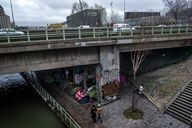
Exile in the land of human rights
Michael Bunel / Le Pictorium
LePictorium_0286319.jpg
Refugees have set up an encampment of some thirty tents under a bridge on the north-eastern Paris ring road. The camp is located on a bank along the Canal de l'Ourcq, rue Delphine Seyrig in Pantin. In the foreground, one of the tents has the British flag printed on the canvas. 07 december 2021. Pantin, France.
In October 2015, the municipality presented eighteen commitments in a document entitled "Mobilizing the Paris community to welcome refugees". The document opens with this sentence: "Paris, like other refugee cities, will rise to the challenge of welcoming the many migrants currently arriving in Europe." One year on, and with the city of Paris already struggling to fulfill its commitment, the dismantling of the Calais Jungle in October 2016 has led to some refugees retreating to the capital. Camps then sprang up, notably in north-east Paris on the banks of the Canal Saint Martin, then at Porte de la Chapelle and Porte d'Aubervilliers. The dismantling of these camps has continued apace. Since June 2015, 300 evacuations and "shelters" of refugees have taken place in Paris and its inner suburbs. These settlements, followed by their evacuation, give the image of an identical repetition of a catastrophic situation of precariousness and a lack of public action. Invisibilized since the last dismantling operations, the exile populations find themselves rejected on the outskirts of the capital. Only a few associations still manage to maintain contact by seeking out the living quarters of those left behind.
In October 2015, the municipality presented eighteen commitments in a document entitled "Mobilizing the Paris community to welcome refugees". The document opens with this sentence: "Paris, like other refugee cities, will rise to the challenge of welcoming the many migrants currently arriving in Europe." One year on, and with the city of Paris already struggling to fulfill its commitment, the dismantling of the Calais Jungle in October 2016 has led to some refugees retreating to the capital. Camps then sprang up, notably in north-east Paris on the banks of the Canal Saint Martin, then at Porte de la Chapelle and Porte d'Aubervilliers. The dismantling of these camps has continued apace. Since June 2015, 300 evacuations and "shelters" of refugees have taken place in Paris and its inner suburbs. These settlements, followed by their evacuation, give the image of an identical repetition of a catastrophic situation of precariousness and a lack of public action. Invisibilized since the last dismantling operations, the exile populations find themselves rejected on the outskirts of the capital. Only a few associations still manage to maintain contact by seeking out the living quarters of those left behind.

Occupation of the Place Sainte Croix Flagey in Brussels
Nicolas Landemard / Le Pictorium
LePictorium_0283655.jpg
In response to a call from several organizations and associations, around 60 tents and 100 undocumented migrants (as well as sympathizers) took up residence in the Place Sainte Croix for a 48-hour occupation, to alert civil society and politicians to the situation of these people.

Occupation of the Place Sainte Croix Flagey in Brussels
Nicolas Landemard / Le Pictorium
LePictorium_0283656.jpg
In response to a call from several organizations and associations, around 60 tents and 100 undocumented migrants (as well as sympathizers) took up residence in the Place Sainte Croix for a 48-hour occupation, to alert civil society and politicians to the situation of these people.

Occupation of the Place Sainte Croix Flagey in Brussels
Nicolas Landemard / Le Pictorium
LePictorium_0283657.jpg
In response to a call from several organizations and associations, around 60 tents and 100 undocumented migrants (as well as sympathizers) took up residence in the Place Sainte Croix for a 48-hour occupation, to alert civil society and politicians to the situation of these people.
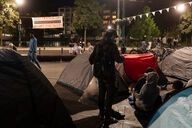
Occupation of the Place Sainte Croix Flagey in Brussels
Nicolas Landemard / Le Pictorium
LePictorium_0283658.jpg
In response to a call from several organizations and associations, around 60 tents and 100 undocumented migrants (as well as sympathizers) took up residence in the Place Sainte Croix for a 48-hour occupation, to alert civil society and politicians to the situation of these people.

Occupation of the Place Sainte Croix Flagey in Brussels
Nicolas Landemard / Le Pictorium
LePictorium_0283659.jpg
In response to a call from several organizations and associations, around 60 tents and 100 undocumented migrants (as well as sympathizers) took up residence in the Place Sainte Croix for a 48-hour occupation, to alert civil society and politicians to the situation of these people.

Occupation of the Place Sainte Croix Flagey in Brussels
Nicolas Landemard / Le Pictorium
LePictorium_0283660.jpg
In response to a call from several organizations and associations, around 60 tents and 100 undocumented migrants (as well as sympathizers) took up residence in the Place Sainte Croix for a 48-hour occupation, to alert civil society and politicians to the situation of these people.

Occupation of the Place Sainte Croix Flagey in Brussels
Nicolas Landemard / Le Pictorium
LePictorium_0283661.jpg
In response to a call from several organizations and associations, around 60 tents and 100 undocumented migrants (as well as sympathizers) took up residence in the Place Sainte Croix for a 48-hour occupation, to alert civil society and politicians to the situation of these people.
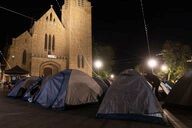
Occupation of the Place Sainte Croix Flagey in Brussels
Nicolas Landemard / Le Pictorium
LePictorium_0283662.jpg
In response to a call from several organizations and associations, around 60 tents and 100 undocumented migrants (as well as sympathizers) took up residence in the Place Sainte Croix for a 48-hour occupation, to alert civil society and politicians to the situation of these people.

new exile camp in Paris
Michael Bunel / Le Pictorium
LePictorium_0270606.jpg
Exiles queue during a food distribution organised by the collective, solifdarité migrants wilson. For the past 9 days, a new camp of exiles has been set up under the metro bridge between La Chapelle and Barbès stations. According to the associations that intervene on the spot, more than 400 exiles, mostly Afghans, are in the camp. Last night, 500 meals were distributed in the camp. 15 November 2022. Paris, France.

new exile camp in Paris
Michael Bunel / Le Pictorium
LePictorium_0270607.jpg
Exiles queue during a food distribution organised by the collective, solifdarité migrants wilson. For the past 9 days, a new camp of exiles has been set up under the metro bridge between La Chapelle and Barbès stations. According to the associations that intervene on the spot, more than 400 exiles, mostly Afghans, are in the camp. Last night, 500 meals were distributed in the camp. 15 November 2022. Paris, France.

new exile camp in Paris
Michael Bunel / Le Pictorium
LePictorium_0270608.jpg
Volunteers from the collective, solidarité migrants wilson distribute meals. For the past 9 days, a new camp of exiles has been set up under the metro bridge between La Chapelle and Barbès stations. According to the associations that intervene on the spot, more than 400 exiles, mostly Afghans, are in the camp. Last night, 500 meals were distributed in the camp. 15 November 2022. Paris, France.

new exile camp in Paris
Michael Bunel / Le Pictorium
LePictorium_0270609.jpg
For the past 9 days, a new camp of exiles has been set up under the metro bridge between La Chapelle and Barbès stations. According to the associations that intervene on the spot, more than 400 exiles, mostly Afghans, are in the camp. Last night, 500 meals were distributed in the camp. 15 November 2022. Paris, France.

new exile camp in Paris
Michael Bunel / Le Pictorium
LePictorium_0270610.jpg
Several exiles queue up for tea or coffee. For the past 9 days, a new exile camp has been set up under the metro bridge between La Chapelle and Barbès stations. According to the associations that intervene on the spot, more than 400 exiles, mostly Afghans, are in the camp. Last night, 500 meals were distributed in the camp. 15 November 2022. Paris, France.
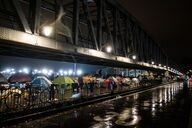
new exile camp in Paris
Michael Bunel / Le Pictorium
LePictorium_0270611.jpg
For the past 9 days, a new camp of exiles has been set up under the metro bridge between La Chapelle and Barbès stations. According to the associations that intervene on the spot, more than 400 exiles, mostly Afghans, are in the camp. Last night, 500 meals were distributed in the camp. 15 November 2022. Paris, France.
Next page
